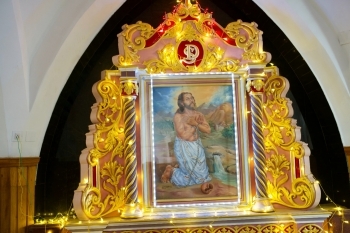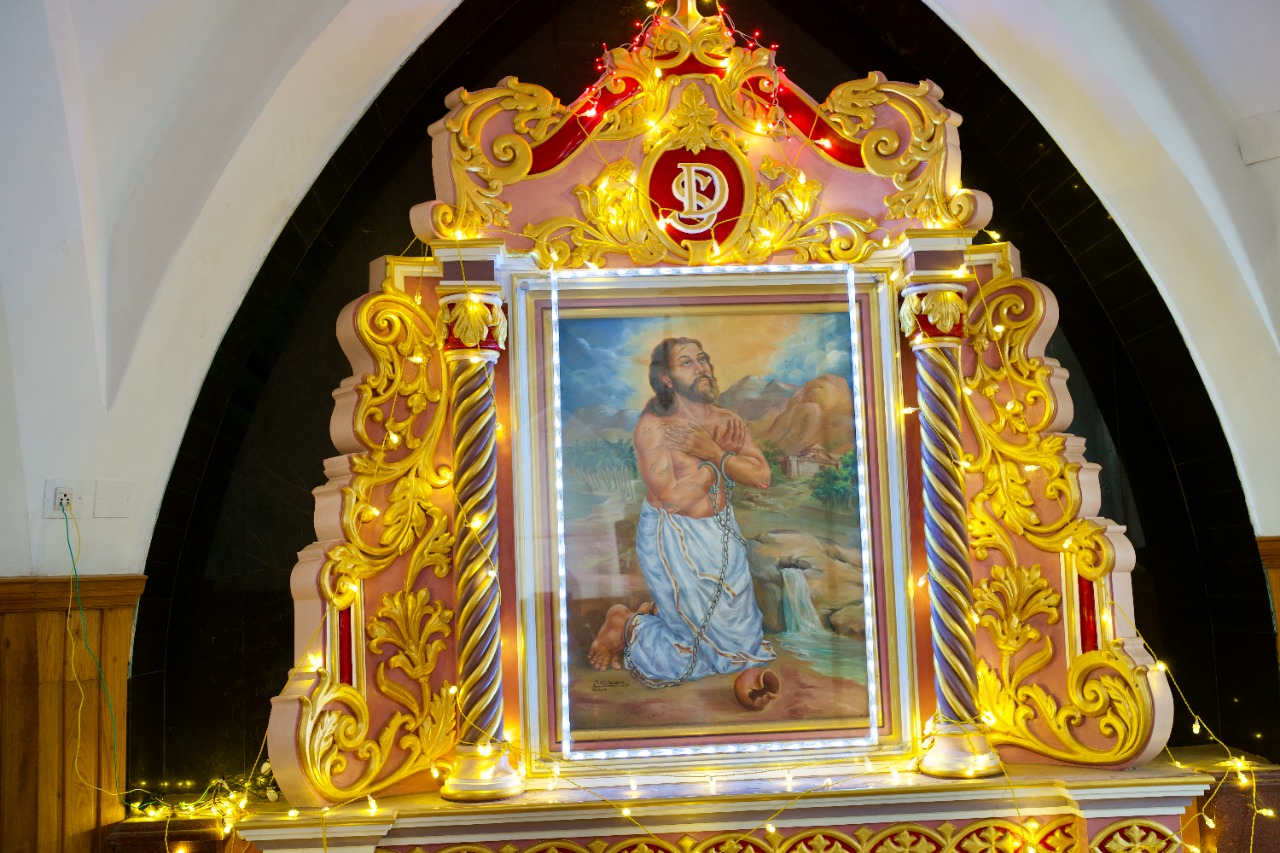
 A. J. Philip
A. J. Philip

Let me begin with a mistake I made. I thought the thanksgiving ceremony of the canonisation of Devasahayam would begin at the St. Xavier’s Cathedral at Kottar where the mortal remains of the martyr are kept. No, there was no function there. Instead, the function was held at Aralvaimozhi, a tongue-twister for many, about 15 kms from the Kottar church in Kanyakumari district in Tamil Nadu.
With a few extra hours at our disposal, we went to the church, an U-shaped impressive Gothic-style building. There was a steady stream of the faithful, more interested in taking selfies besides a newly-erected statue of Devasahayam and his freshly-painted and brightly-lit tomb. Many of them were seen touching the tomb and making a sign of the cross in divine obsecration.
After an early, pure vegetarian lunch, we left for Aralvaimozhi, an absolute delight for any visitor. The Western Ghats that have protected the area from invaders for centuries have lost some of their green cover but they remain as towering as they were ever. In local parlance, the area is called Kattadi Mala because wind is constant there. We could see many windmills in the distance.
There is a shrine at Kattadi Mala, erected in memory of Devasahayam. We gave it a skip to go to the venue, parked the car on the roadside and walked about a kilometre to reach the huge pandals erected for the function. Multi-hued flags on both sides of the road with the Ghats as the backdrop provided a sight to savour. There was a huge stage flanked by two smaller stages in four makeshift pandals joined together. They could withstand moderate to heavy rains and wind.
Yes, we were too early to reach. A kindred soul in cassock inquired whether we had our lunch. No, it was not just to start a polite conversation. We could see everyone there, including a large number of policemen on duty, being provided food packets. He was happy to know that we came all the way from New Delhi via Kayamkulam to witness the function.
I wondered whether the pandals would be filled up as there were at least 10,000 chairs laid to welcome visitors. Girls and boys in dance costumes were seen rehearsing while a large group of women in brown saris each holding a steel pot with a coconut inside it were preparing themselves to receive the guests in the traditional Tamil style.
The central stage was where the mass was to be said and the one on the right was for the cultural show, while the one on the left was for the large choir to perform. It was a musical extravaganza that awaited the audience which began trooping into the pandals. Those who enjoy nadaswaram recitals were not getting bored as a group of professionals were performing on the stage.
By the way, it was not for the scenic beauty of Aralvaimozhy that the place was chosen for the thanksgiving ceremony. Devasahayam’s canonisation is significant for the Indian church, as he is the first layman to be elevated to sainthood in India.
As the story goes, Devasahayam was born to Vasudevan Namboothiri and Devaki Ammal 310 years ago. Brahmin men marrying Nairs was common. It was known as sambantham. In fact, in a Brahmin family, the eldest son married a Brahmin girl while the rest of the boys married Nair women. Children born of such intercaste marriage took the caste name of the mother.
That is how Devasahayam was named Neelakantan, another name for Siva. As was the practice, he learnt martial arts and joined the military service of the Travancore Maharaja, who ruled his kingdom that extended up to Thiruvananthapuram in the west to Kanyakumari in the south from Padmanabhapuram palace, not very far from Aralvaimozhi. Incidentally, it is, perhaps, the oldest palace in the country.
Marthanda Varma, in whose period Kollam and Kayamkulam were annexed and made part of Travancore, was in power at that time. It was with great difficulty that he annexed Kayamkulam, as can be inferred by the huge painting of the annexation ceremony that adorns the wall at the Padmanabhapuram Palace that occupies five-six acres of land.
Another painting there depicts the Colachel war in which Travancore defeated the Dutch forces led by Delenoid, who was arrested and jailed. The King knew that, though defeated, Delenoid was an expert in naval warfare. He was, therefore, released from jail and employed to raise a naval force. In due course, Neelakantan and Delenoid became close to each other.
Delenoid was evangelically inclined and he led Neelakantan on the Biblical path eventually leading to his baptism. His baptismal name was Devasahayam Pillai. He turned out to be popular and when people began to follow his religious practices, the state turned against him and he was shot dead at Katradimalai (Kattadi Mala). He became a martyr like the protomartyr St. Stephen. He was elevated to sainthood by Pope Francis at the Vatican on May 15, 2022.
I realised how much the people of Tamil Nadu took pride in the canonisation of Devasahayam when all the roads led to the venue and the pandals were all filled up in no time. Occasional breezes kept the pandals cool and tolerable.
The function began when the chief guest, Archbishop Leopoldo Girelli, who is the Apostolic Nuncio (Ambassador of the Vatican) to India, arrived in the company of Cardinal Oswald Gracias and Cardinal George Alencherry and many archbishops and bishops as the clock struck 2:30 pm. What followed was a breathtaking cultural programme brilliantly choreographed and presented with audio-visual aids.
There was a series of dances based on songs composed, especially for the function. Unfortunately, I could not follow the songs as they were in Tamil but I could make out that each song covered a period in the life of Devasahayam like his birth in ordinary circumstances, his childhood, when he questioned caste-based discrimination, his teenage years, when he learned martial arts, his service as a soldier of the Maharaja, friendship with Delenoid, accepting Jesus as his saviour, confrontation with the Maharaja and, finally, his execution at the hands of a soldier, who gets the gun blessed by him before he uses it.
As the life story progressed on the stage, the huge electronic screen showed the cinematic presentation of the same episodes from the life of Devasahayam. Those who could not follow Tamil could easily follow the story.
Hundreds of children would have practiced for several days before they could summon up courage to perform on the stage, witnessed by tens of thousands of people at the venue and many more on television and computer/mobile screens all over the world.
The garrulous announcer seemed to have taken a decision not to mention any word other than Tamil while helping the audience understand the goings-on, both on the stage and off the stage. Maybe because they knew that Aralvaimozhi was once part of Travancore where the state language was Malayalam, the choir sang the Lord’s Prayer in Malayalam. It was at once melodious and beautiful.
After the cultural programme and a brief interval, what followed was a ritual the audience would have loved to give a miss. There were a large number of guests, including the Apostolic Nuncio, state ministers, political and religious leaders and descendants of Devasahayam who needed to be honoured and felicitated. If it took a long time, it could not be helped.
Thanksgiving in the Catholic tradition is never complete without the Holy Mass. The cultural programme and the choir singing were all a prelude to the mass. The central stage was beautifully and aesthetically converted into a huge altar using liberally flowers of various hues. There were hundreds of priests to witness and take part in the Eucharist.
For once I realized why the women in brown were practising what I could not fathom. The Apostolic Nuncio and other Cardinals, Archbishops and others were led to the Altar only after the women greeted them with steel vessels filled with items like coconut, leaves and flowers used for traditional welcome.
The mass began with a statement: “Swimming against the current and shining with unique qualities are the salient characteristics of history makers. Today the annals of history are carving the name of Martyr St. Devasahayam in golden letters, who left no stone unturned to proclaim Jesus and His words, who strove for the upliftment of the marginalised and the discriminated ignorant people of his soil.
“On seeing the life of this humble person, who fell as a seed on the grounds of Katradi Malai, Kottar, in Kanyakumari district of Tamil Nadu, has now been raised by God to bear many fruits, by elevating him to the zenith of sainthood. This could have been achieved by the Saint because of his self-sacrifice, his willingness to die for Christ in all humility and patiently undergoing all kinds of tortures meted out to him.
“On this auspicious day, we are all gathered here in the nearest vicinity where he faced his heroic death as a martyr. It is highly fitting for all of us who are to participate in the Eucharistic celebration, as a thanksgiving to our Lord and Saviour Jesus Christ grasp and inhale every bit of his staunch faith for which he stood for till his last breath…”.
The formal mass began with the Apostolic Nuncio to India lighting the lamp and the choir singing the Tamil hymn “Ontrinaivom pankerppom -irai/ Aatchitin kanavukar meippadave/ Narcheithi arivippom”. I looked at the watch. It was already 5:45 pm. If I waited for the mass to end, it would take another two-three hours for us to take the road as the large crowd had to disperse. There were thousands of cars, buses and other vehicles parked on the ground and on the roadsides.
We quietly left the venue, walked towards the car only to find hundreds of people still arriving to attend the mass. I also had another purpose to leave early as I wanted to visit the shrine at Kattadimala, which commemorates the martyrdom of Devasahayam, before the sunset.
It was a short drive from the main road. There were a large number of people assembled there too. They were watching the mass on the huge screen put up in the shrine. A huge statue of Mother Mary, the patron saint of India, welcomed the people with open hands from the hilltop that can be seen from a long distance.
The peaks on the Western Ghats were resplendent with clouds forming different patterns against their backdrop. Our driver was a little impatient as he had 190 kms to drive to return to Kayamkulam.
As we hit the road, I just thought how the situation would have been if Devasahayam was canonised at Aralvaimozhi, and not at the Vatican. I am sure lakhs of people would have converged for the ceremony.
There are some who deny that Devasahayam ever existed. They also say that the Travancore Maharaja could not have ordered his killing. They do not know the history of Travancore. There was one Kerala Varma Valiya Koilthampuran who was known as the Kerala Kalidasa. He had an outstanding command of English, Sanskrit and Malayalam.
There was a time when he hobnobbed with Christianity and he got into the good books of the British. He had to pay a price for it, as he was imprisoned for five long years. That his wife was the Rani of Travancore did not help him. Finally, he was released only after the King died.
Devasahayam was a plebeian, married to Bhargavi, an ordinary lady, in comparison. Whatever be the case, Devasahayam will now be venerated as the seventh saint of the Catholic Church in India. How truly it is said, “What you are is God's gift to you, what you become is your gift to God”.
ajphilip@gmail.com